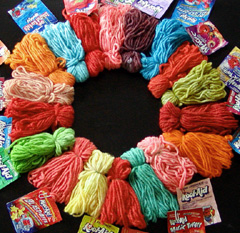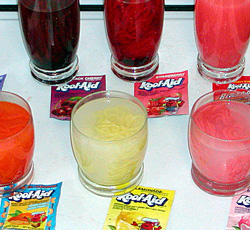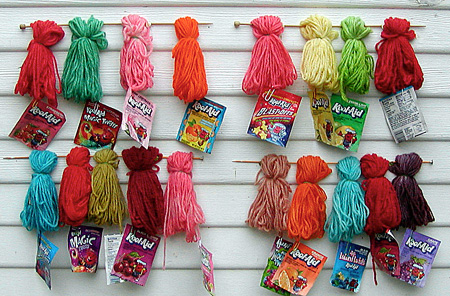|
by
Kristi
Porter
 I
must confess to a feeling of postmodern nostalgia
for what-never-was tinged with some sort of
tweenage pop-icon fandom when I scoured the
city's grocery stores in search of the elusive
lemon-lime. I felt sheepish as a paid for my
16 gaily colored packets. And I felt giddy when
I added water and the bright colors and fruity
smells issued forth. I
must confess to a feeling of postmodern nostalgia
for what-never-was tinged with some sort of
tweenage pop-icon fandom when I scoured the
city's grocery stores in search of the elusive
lemon-lime. I felt sheepish as a paid for my
16 gaily colored packets. And I felt giddy when
I added water and the bright colors and fruity
smells issued forth.
But
I wasn't making Kool-Aid for myself or even
the kids to drink. It was for my yarn. You see,
Kool-Aid is an easy, fabulous and fun way to
create your own hand-dyed yarn.
Since
powdered drink mixes are readily available and
reasonably non-toxic, it makes a great entrée
into the world of fiber dyeing in your own kitchen.
No specialized equipment is needed. I will,
however, offer a few words of caution. First,
avoid inhaling the powder; that wouldn't be
good for you. Second - perhaps obvious since
you are dyeing things - it stains! Avoid getting
it on clothes and wear rubber gloves if you
don't want your hands to evidence your work
for a couple of days. A little bleach or baking
soda should take care of your work surface,
though spreading out a garbage bag before you
begin is not a bad idea.
What
fibers to use:
Kool-Aid
dyeing works only on animal fibers: wool, mohair,
alpaca -- even human hair! It doesn't work on
cotton or synthetics, though, so use pure wool
yarn for best results. Blended yarns containing
a high percentage of wool do work, but the non-animal
part of the yarn won't take the dye and you
won't get very saturated colors. You can use
this to your advantage: a cotton-wrapped wool
boucle will come out colored with a white wrap.
You need not use only uncolored yarns, either.
Start with a natural tweed or over-dye a pastel.
You can also dye rovings to great effect with
this method. Just card and spin a few colors
together once they're dry. You'll feel like
an artist in no time!
What
you'll need:
 Wool
yarn tied loosely in skeins so dye can penetrate
Wool
yarn tied loosely in skeins so dye can penetrate
 1 package of unsweetened drink mix per ounce
of yarn
1 package of unsweetened drink mix per ounce
of yarn
[for saturated colors]
 Large
pot or microwave-safe dish
Large
pot or microwave-safe dish
Optional
equipment for variegated or hand-painted yarns:
 steamer basket for pot
steamer basket for pot
 plastic cups
plastic cups
 large syringe or turkey baster
large syringe or turkey baster
What
to do:
 To
get your yarn ready, wash it lightly in mild
soap and then let it soak in the sink as you
continue your preparations. You don't need to
add vinegar as you would with other dyeing techniques
because Kool-Aid is very acidic! To
get your yarn ready, wash it lightly in mild
soap and then let it soak in the sink as you
continue your preparations. You don't need to
add vinegar as you would with other dyeing techniques
because Kool-Aid is very acidic!
If
you want your yarn dyed a single color, either
straight from the package or using your own
special blend of flavors, empty your packages
of of drink mix [important: use no sugar!]
into your pot or microwave-safe dish with some
water. Stir to dissolve. Add your yarn and enough
water to cover it. The amount of water doesn't
matter; the ratio of dye to yarn does. Use less
Kool-Aid for lighter colors, more for darker
colors.
 There
are two basic methods of setting the dye: stovetop
or microwave. For the stovetop, heat the yarn-filled
pot to nearly boiling. Turn it off and let it
sit, covered, for at least half an hour, stirring
a few times. If you prefer the microwave, zap
your yarn-filled dish for two minutes. Let the
yarn rest for a few minutes, then zap it again
for another two minutes. With either method,
you'll know your yarn is ready if the water
is mostly clear. [This means the yarn should
have absorbed all the dye.] If it's not, you
might want to heat it again. Let it cool. There
are two basic methods of setting the dye: stovetop
or microwave. For the stovetop, heat the yarn-filled
pot to nearly boiling. Turn it off and let it
sit, covered, for at least half an hour, stirring
a few times. If you prefer the microwave, zap
your yarn-filled dish for two minutes. Let the
yarn rest for a few minutes, then zap it again
for another two minutes. With either method,
you'll know your yarn is ready if the water
is mostly clear. [This means the yarn should
have absorbed all the dye.] If it's not, you
might want to heat it again. Let it cool.
When
the yarn has cooled, rinse it thoroughly in
water the same temperature as the yarn [shocking
wool with cold water could cause it to felt].
Wash the yarn in mild soap, rinse again and
hang to dry.
Hand-Painting:
Hand
painting your yarn is as easy as finger-painting
and at least as much fun! Prepare your skeins
as you did for the basic method above. Then
lay them out flat on a plastic bag.
Choose
the colors you want to use yarn and mix each
one in a plastic cup with a few tablespoons
of water per package. You still want to use
roughly one package of Kool-Aid per ounce of
yarn. You can use as few as two colors or as
many as twelve, but you will want to be careful
about contrasting colors running into one another
unless dirty brown is part of your aesthetic
vision.
 Suck
up some of your beverage mix with a turkey baster
or syringe and squirt it carefully onto the
yarn. If a variegated yarn is what you are after,
imagine your skein to be a pie and apply the
dye in wedges, or stretch it out lengthwise
and apply the dye in stripes. Rinse the baster/syringe
between colors to prevent unwanted mixing. If
a more subtle, mottled color effect is what
you want, pour or squirt the various colors
as the spirit moves you. Suck
up some of your beverage mix with a turkey baster
or syringe and squirt it carefully onto the
yarn. If a variegated yarn is what you are after,
imagine your skein to be a pie and apply the
dye in wedges, or stretch it out lengthwise
and apply the dye in stripes. Rinse the baster/syringe
between colors to prevent unwanted mixing. If
a more subtle, mottled color effect is what
you want, pour or squirt the various colors
as the spirit moves you.
Depending
on how big your skeins are, you might need to
turn them over carefully and dye them on the
back side, too. Then, with plastic gloves or
baggies on your hands, gently press on the yarn
to move the dye through all the layers. Keep
an eye out for white spots, particularly where
the skein is tied.
Now
gently pick up your skein and place it in the
microwave dish or steamer basket. Microwave
as above or steam for 30-45 minutes over hot
water (you can turn the burner off and just
let it sit, covered, after it's good and steamy).
Cool and wash your yarn.

top
row [L to R]:
 strawberry
strawberry
 changin' cherry
changin' cherry
 pink lemonade
pink lemonade
 mandarina tangerina
mandarina tangerina
 strawberry starfruit
strawberry starfruit
 lemonade
lemonade
 lemon lime
lemon lime
 tropical punch
tropical punch |
bottom
row:
 blue moon berry
blue moon berry
 grape illusion
grape illusion
 switchin' secret
switchin' secret
 black cherry
black cherry
 slammin' strawberry kiwi
slammin' strawberry kiwi
 blastin' berry cherry
blastin' berry cherry
 orange
orange
 ice blue raspberry lemonade
ice blue raspberry lemonade
 cherry
cherry
 grape
grape |
Rest
assured, your finished products will be washable.
Follow the directions for the yarn you've used.
If you've washed the yarn thoroughly after dyeing
it, you don't have to worry about the colors
bleeding in the wash. Just give them the care
you would any hand-knit item. Some fading may
occur over time, particularly if they are exposed
to a lot of sunlight. Though the fruity smell
will fade, the bright colors will last for years!
Story
and images ©2002 Kristi Porter
Kool-Aid name, packaging and logos © KF
Holdings. You knew that, though.
|

